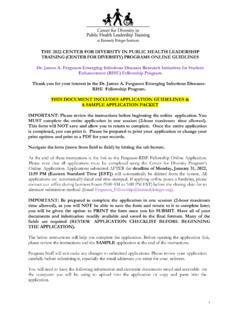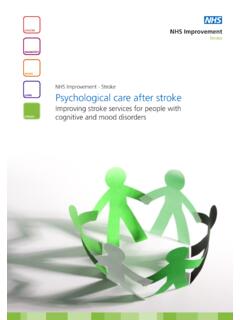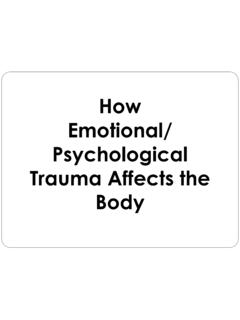Transcription of The Effects of Psychological Trauma on Children with ...
1 REVIEW PAPERThe Effects of Psychological Trauma on Children with AutismSpectrum Disorders: a Research ReviewDaniel W. Hoover1 Received: 13 May 2015 /Accepted: 18 June 2015 /Published online: 9 July 2015#Springer Science+Business Media New York 2015 AbstractTraumatic events such as abuse, bullying, and ex-posure to violence are commonplace among typically devel-oping Children and occur at least as often among those withautism spectrum disorder (ASD). Children with ASD are vul-nerable to traumatization due to their deficits in social com-munication and emotion regulation. Research on posttraumat-ic symptoms among Children with ASD is reviewed. Bullyinghas received much attention while there is a paucity of re-search on other types of Trauma . Anxiety, social isolation,and developmental regression are associated with Trauma . Fur-ther research is needed to clarify the symptom presentationand frequency of PTSD.
2 Sensitive self-report measures areneeded as well as validation of existing measures for assessingtrauma in this spectrum maltreatmentChildren with autism are exposed to traumatic events at leastas often as their typically developing peers but the Effects inthis group are not well understood (Sullivan2009; Turneret ). Child maltreatment and other potentially traumat-ic experiences of youth are a major national health problemand frequently cited priority for research and intervention(Fairbank2008). Traumatic experiences include childhoodmaltreatment such as physical and sexual abuse, emotionalabuse, and physical neglect. Other types of traumaticexperiences include death and separation from loved ones,witnessing domestic violence or other community violence,verbal and physical bullying by peers, exposure to natural andman-made disasters, and painful medical interventions,among others (National Child Traumatic Stress Network2012 ).
3 A recent survey of child maltreatment such as physicalabuse and neglect reported a Trauma incidence rate of per1,000 Children in the USA in 2013 (US Department of Healthand Human services Department of Health and Human Ser-vices, Administration for Children and Families, Administra-tion on Children , Youth and Families, Children sBureau2015 ). In a nationally representative study, 68 % percent ofyouth were found to have experienced a potentially traumaticevent by the age of 16. Less than one half of 1 % of thechildren and youth were subsequently diagnosed with post-traumatic stress disorder (PTSD) but for those who experi-enced more than one traumatic event the rate of PTSD wasnearly 50 %. Other Trauma -related problems such as academic,emotional, and somatic difficulties were present in more than20 % of the exposed Children (Copeland et ).
4 Posttraumatic stress disorder is described in the DSM-5 asa syndrome arising from witnessing, directly experiencing, orbeing otherwise exposed to serious physical or sexual vio-lence, threats to bodily integrity, or death of family members(American Psychiatric Association2013 ). The central symp-tom pattern is as follows: (a) re-experiencing of traumaticthoughts or images through memories, dreams, or intrusivethoughts; (b) negative cognitive and mood states related tothe Trauma ; and (c) alteration of physical arousal related tothe Trauma . Other types of adjustment difficulties, includingimpairment of relationships and attachment, avoidance oftraumatic reminders, and behavior and emotional problemsare labeledBtrauma related symptoms^while they may notmeet full criteria for PTSD (Goenjian et ;Perkonigg*Daniel W. Center for Child and Family Traumatic Stress at KennedyKrieger Institute, 1750 East Fairmount Ave.)
5 2nd Floor,Baltimore, MD 21231, USARev J Autism Dev Disord (2015) 2:287 299 DOI ). Trauma Effects Children differently at each stageof development and can interfere with the acquisition of de-velopmental milestones (Lieberman et ; Trickett et ). Males and females are exposed to violence and abuse atabout the same rate (US Department of Health and HumanServices Department of Health and Human services , Admin-istration for Children and Families, Administration on Chil-dren, Youth and Families, Children sBureau2015 ). However,there are gender differences in the expression of Trauma -related symptoms. Males on average tend to display moreexternalizing behavior and females tend to display more inter-nalizing behavior with heightened susceptibility to PTSD es-pecially following sexual abuse (Darves-Bornoz et ;Evans et ; Walker et ).
6 Broad and long-lastingnegative health Effects have been found in those exposed totrauma in childhood (Felitti et ).Given the high percentage of traumatic exposures amongyouth, it is likely that a significant proportion of those withautism spectrum disorder (ASD) have been exposed to traumawith resulting mental health symptoms. Several factors mayset them up for traumatization. They are more socially isolat-ed, less accepted and liked by peers, and more often excludedand ridiculed (Carter2009 ; Rotheram-Fuller et ). Chil-dren with ASD lack the social support networks that havebeen shown to protect or buffer Children from the Effects ofpeer bullying (Bauminger and Kasari2000 ; ). Children with ASD have been shown to become more angryand upset in response to bullying than typically developingchildren, which could lead to more targeted aggression direct-ed toward them (Rieffe et ).
7 Language delays may getin the way of reporting abuse or expressing reactions to Trauma (Cook et ). Verbal expression and processing form akey part of most therapies for Trauma in Children but may bedifficult or impossible for Children with autism (Howlin andClements1995 ). Perhaps because of these developmental vul-nerabilities they show high rates of co-morbid anxiety andother emotional and behavioral problems (Konst and Matson2014 ; ). They may therefore be expected tohave more severe emotional reactions to traumatic with childhood Trauma , ASD is being increasingly di-agnosed, a trend that gained momentum with the labeling of awider range of symptoms as pertaining to autism in the DSM-IV (American Psychiatric Association1994). Recent CDCestimates in the USA indicate a prevalence rate of 1 in 68children being identified with ASD in 2010 based on nationalsurvey data, whereas similar surveillance methods identified arate of 1 in 150 Children in 2002 (Centers for Disease Controland Prevention2014).
8 Estimates vary based on method ofassessment, country or region studied, and definition ofASD but have shown a general trend of increasing prevalencethat may be starting to level off (Tsai2014 ). The increasedprevalence rate is most likely due to changes in diagnosticcriteria but may also reflect genetic and/or environmentalfactors (Simonoff2012 ). ASDs are characterized by pervasivedevelopmental deficits in social communication and interac-tion as well as rigid, repetitive patterns of behavior, interests,or activities. The DSM-5 groups those diagnosed into threeseverity levels based on functional behavior. At the lower-functioning end of the spectrum are those who requireBverysubstantial support^due to severe deficits in verbal and non-verbal communication and often display markedly impairingrigidity and repetitive behavior. At the higher-functioning endare individuals who show difficulty initiating and maintainingsuccessful social contact, may be quite inflexible in behaviorand routines, and have difficulty organizing and transitioningbetween activities (American Psychiatric Association2013 ).
9 Outside of the growing literature on bullying which com-prises the majority of studies of potential Trauma in childrenwith ASD, there is little clear information about the rate oreffects of traumatization in this population. The purposes ofthis article are to review the literature regarding the types oftraumatic exposure and symptoms occurring in Children withASD, address measurement problems arising in the assess-ment of this population, and to make recommendations forfurther investigation in Children with ASDFor the purposes of this review, Psychinfo and PubMed weresearched using the following autism related keywords:autism,Asperger,PDD,andPDD-NOSi n combination with Trauma -related keywords:posttraumatic/post-traumatic,PT SD,childabuse,child neglect,interpersonal violence,childmaltreatment,domestic violence,peer victimization,andbullying.
10 Reference lists in the identified articles were alsosearched for relevant were selected for review if they were: (a) empiricalresearch published in a peer-reviewed journal of any date up tothe current issue; (b) non-dissertation; (c) reported in English;(d) clearly identified ASD in Children and youth; and (e) re-ported a quantifiable assessment of PTSD or specified emo-tional, behavioral, and/or functional problems associated withpotentially traumatic experiences. Case studies, purely theo-retical, position, or clinical papers without quantitative datawere excluded from this research is a clear divide in the literature between studies ofbullying (used interchangeably here withpeer victimization)and studies of child Trauma , abuse, and other distinction was followed in presenting articles for thisreview. Twenty-two studies of bullying were found that metcriteria A D above.









